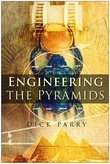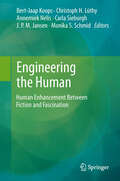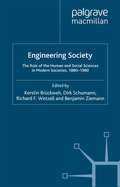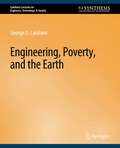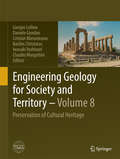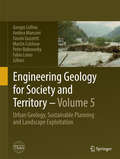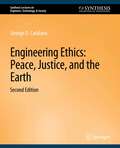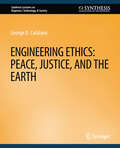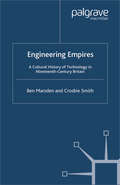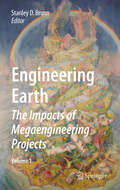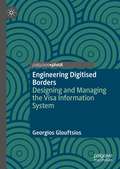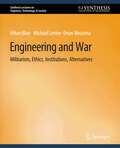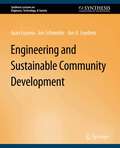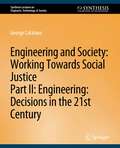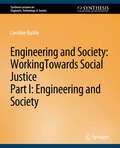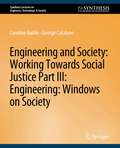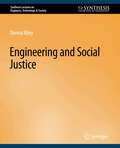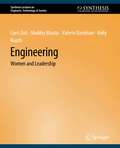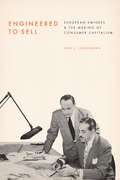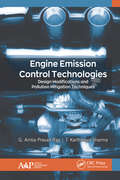- Table View
- List View
Engineering the Pyramids
by Dick ParryUsing archaeological records and the basic principles of engineering, Dick Parry provides an account of the design history of the pyramids, the techniques and organization needed and insights into why the pyramids were designed as they were.
Engineering the Human: Human Enhancement Between Fiction and Fascination
by Bert-Jaap Koops, Christoph H. Lüthy, Annemiek Nelis, Carla Sieburgh, J. P. M. Jansen and Monika S. SchmidThe volume is collection of articles treating the topic of human improvement/enhancement from a variety of perspectives – philosophical, literary, medical, genetic, sociological, legal etc. The chapters in this volume treat not only those aspects that most immediately come to mind when one thinks of ‘human enhancement’, such as genetic engineering, cloning, artificial implants and artificial intelligence etc. Somewhat less obvious aspects include evolutionary perspectives in connection with the prolongation of the human lifespan, plastic surgery since its beginnings, and questions such as whether the distinction between ‘natural’ and ‘artificial’ can really be drawn at all and how it has been conceived across the ages, or what the legal implications are of recent developments and techniques. Many papers make links to the representation of these developments in popular culture, from Jules Verne through Aldous Huxley to the movie Gattaca, address the hopes and fears that come with them as well as the question how realistic these are. While all chapters are written by scientists at the international top of their respective fields, all are accessible to a non-specialist audience and eminently readable. We believe that they represent a state-of-the art overview of questions that are of interest to a large audience. The book thus targets a non-specialist audience with an interest in philosophical, sociological, scientific and legal issues involved in both traditional and recent matters concerning the desire of mankind to improve itself, the human body, the human mind and the human condition. It is unique in that it brings together all these aspects within a coherent and cohesive collection.
Engineering Society: The Role of the Human and Social Sciences in Modern Societies, 1880-1980
by Kerstin Brückweh Richard F. WetzellExplaining crime by reference to abnormalities of the brain is just one example of how the human and social sciences have influenced the approach to social problems in Western societies since 1880. Focusing on applications such as penal policy, therapy, and marketing, this volume examines how these sciences have become embedded in society.
Engineering, Poverty, and the Earth (Synthesis Lectures on Engineers, Technology, & Society)
by George D. CatalanoIn the present work, the growing awareness in engineering of the profession’s responsibility towards the environment and the poor is considered. The following approach is taken: a brief overview of the issues of poverty particularly in the U.S. and the deterioration of the natural world with a focus on the Arctic is provided. Case studies involving New Orleans in the aftermath of Hurricane Katrina and the status of polar bears in a time of shrinking Arctic ice cover are detailed. Recent developments in engineering related to the issues of poverty and the environment are discussed. A new paradigm for engineering based on the works of Leonardo Boff and Thomas Berry, one that places an important emphasis upon a community, is explored.
Engineering Geology for Society and Territory - Volume 8: Preservation of Cultural Heritage
by Giorgio Lollino Daniele Giordan Cristian Marunteanu Basiles Christaras Iwasaki Yoshinori Claudio MargottiniThis book is one out of 8 IAEG XII Congress volumes, and deals with the preservation of cultural heritage. In 1972, the World Heritage Convention linked in a single framework the concepts of nature conservation and the preservation of cultural sites. Since then, engineering geology is enlarging its contributions to national and international projects on this topic and is extending its interests to key issues like: safeguarding of monuments and sites from geotechnical perspectives; advanced monitoring; investigations on cultural landscapes; development of geo-databases for cultural heritage classification; studies on the interactions between humankind, natural landscape evolution and cultural heritage; analysis of weathering and deterioration of rock properties of monuments; risk analysis of sites affected by natural hazards and many others. With the contributions in this book, engineering geologists, conservation scientists and further experts from other natural, social and economic sciences, as well as representatives of international organizations and national and local administrative authorities exchange their ideas and practices on culture heritage preservation by presenting both local case studies and multidisciplinary international projects. The Engineering Geology for Society and Territory volumes of the IAEG XII Congress held in Torino from September 15-19, 2014, analyze the dynamic role of engineering geology in our changing world and build on the four main themes of the congress: Environment, processes, issues and approaches. The congress topics and subject areas of the 8 IAEG XII Congress volumes are: Climate Change and Engineering Geology. Landslide Processes. River Basins, Reservoir Sedimentation and Water Resources. Marine and Coastal Processes. Urban Geology, Sustainable Planning and Landscape Exploitation. Applied Geology for Major Engineering Projects. Education, Professional Ethics and Public Recognition of Engineering Geology. Preservation of Cultural Heritage.
Engineering Geology for Society and Territory - Volume 5: Urban Geology, Sustainable Planning and Landscape Exploitation
by Giorgio Lollino Andrea Manconi Fausto Guzzetti Martin Culshaw Peter Bobrowsky Fabio LuinoThis book is one out of 8 IAEG XII Congress volumes, and deals with the theme of urban geology. Along with a rapidly growing world population, the wave of urban growth continues, causing cities to swell and new metropolitan centers to emerge. These global trends also open new ventures for underground city development. Engineering geology plays a major role in facing the increasing issues of the urban environment, such as: finding aggregates for construction works; providing adequate water supply and waste management; solving building problems associated to geological and geomorphological conditions; evaluating host rock conditions for underground constructions; preventing or mitigating geological and seismic hazards. Furthermore, this book illustrates recent advancements in sustainable land use planning, which includes conservation, protection, reclamation and landscape impact of open pit mining and alternative power generation. The Engineering Geology for Society and Territory volumes of the IAEG XII Congress held in Torino from September 15-19, 2014, analyze the dynamic role of engineering geology in our changing world and build on the four main themes of the congress: environment, processes, issues and approaches. The congress topics and subject areas of the 8 IAEG XII Congress volumes are: 1. Climate Change and Engineering Geology 2. Landslide Processes River Basins 3. Reservoir Sedimentation and Water Resources 4. Marine and Coastal Processes Urban Geology 5. Sustainable Planning and Landscape Exploitation 6. Applied Geology for Major Engineering Projects 7. Education, Professional Ethics and Public Recognition of Engineering Geology 8. Preservation of Cultural Heritage
Engineering Ethics: Peace, Justice, and the Earth, Second Edition (Synthesis Lectures on Engineers, Technology, & Society)
by George D. CatalanoA response of the engineering profession to the challenges of security, poverty and underdevelopment, environmental sustainability, and native cultures is described. Ethical codes, which govern the behavior of engineers, are examined from a historical perspective linking the prevailing codes to models of the natural world. A new ethical code based on a recently introduced model of Nature as an integral community is provided and discussed. Applications of the new code are described using a case study approach. With the ethical code based on an integral community in place, new design algorithms are developed and also explored using case studies. Implications of the proposed changes in ethics and design on engineering education are considered. Table of Contents: Preface / Acknowledgments / Introduction / Engineering Ethics / Models of the Earth / Engineering in a Morally Deep World / Engineering Design in a Morally Deep World / Implications for Engineering Education / Final Thoughts / References / Author's Biography
Engineering Ethics: Peace, Justice, and the Earth (Synthesis Lectures on Engineers, Technology, & Society)
by George D. CatalanoA response of the engineering profession to the challenges of security, poverty and under-development, and environmental sustainability is described. Ethical codes, which govern the behavior of engineers, are examined from a historical perspective linking the prevailing codes to models of the natural world.Anewethical code based on a recently introduced model of Nature as an integral community is provided and discussed. Applications of the new code are described using a case study approach. With the ethical code based on an integral community in place, a new design algorithm is developed and also explored using case studies. Implications of the proposed changes in ethics and design on engineering education are considered.
Engineering Empires: A Cultural History of Technology in Nineteenth-Century Britain
by B. Marsden C. SmithEngineers are empire-builders. Watt, Brunel, and others worked to build and expand personal and business empires of material technology and in so doing these engineers also became active agents of political and economic empire. This book provides a fascinating exploration of the cultural construction of the large-scale technologies of empire.
Engineering Earth: The Impacts of Megaengineering Projects
by Stanley D. BrunnThis is the first book to examine the actual impact of physical and social engineering projects in more than fifty countries from a multidisciplinary perspective. The book brings together an international team of nearly two hundred authors from over two dozen different countries and more than a dozen different social, environmental, and engineering sciences. Together they document and illustrate with case studies, maps and photographs the scale and impacts of many megaprojects and the importance of studying these projects in historical, contemporary and postmodern perspectives. This pioneering book will stimulate interest in examining a variety of both social and physical engineering projects at local, regional, and global scales and from disciplinary and trans-disciplinary perspectives.
Engineering Digitised Borders: Designing and Managing the Visa Information System
by Georgios GlouftsiosThis book focuses on the Visa Information System (VIS): a large-scale data infrastructure interconnecting a multiplicity of state authorities that enact border security and migration management in the European Union. The VIS is embedded within a setting of pan-European IT systems that filter international mobility, identify threatening elements, hamper the travels of poor, racialized, and alienated subjects, while at the same time facilitate the circulation of those expected to generate financial and other kinds of capital. The book examines the engineering of the VIS by analyzing how it was designed before its deployment in the field of border security, and how it is maintained to ensure continuous and secure operation. It illustrates how engineering processes that render the VIS functional are not just technoscientific, but inherently political, as they (re)configure and maintain the power to govern international mobility by digital means.
Engineering and War: Militarism, Ethics, Institutions, Alternatives (Synthesis Lectures on Engineers, Technology, & Society)
by Ethan Blue Michael Levine Dean NieusmaThis book investigates the close connections between engineering and war, broadly understood, and the conceptual and structural barriers that face those who would seek to loosen those connections. It shows how military institutions and interests have long influenced engineering education, research, and practice and how they continue to shape the field in the present. The book also provides a generalized framework for responding to these influences useful to students and scholars of engineering, as well as reflective practitioners. The analysis draws on philosophy, history, critical theory, and technology studies to understand the connections between engineering and war and how they shape our very understandings of what engineering is and what it might be. After providing a review of diverse dimensions of engineering itself, the analysis shifts to different dimensions of the connections between engineering and war. First, it considers the ethics of war generally and then explores questions of integrity for engineering practitioners facing career decisions relating to war. Next, it considers the historical rise of the military-industrial-academic complex, especially from World War II to the present. Finally, it considers a range of responses to the militarization of engineering from those who seek to unsettle the status quo. Only by confronting the ethical, historical, and political consequences of engineering for warfare, this book argues, can engineering be sensibly reimagined.
Engineering and Sustainable Community Development (Synthesis Lectures on Engineers, Technology, & Society)
by Juan Lucena Jen Schneider Jon A. LeydensThis book, Engineering and Sustainable Community Development, presents an overview of engineering as it relates to humanitarian engineering, service learning engineering, or engineering for community development, often called sustainable community development (SCD). The topics covered include a history of engineers and development, the problems of using industry-based practices when designing for communities, how engineers can prepare to work with communities, and listening in community development. It also includes two case studies -- one of engineers developing a windmill for a community in India, and a second of an engineer "mapping communities" in Honduras to empower people to use water effectively -- and student perspectives and experiences on one curricular model dealing with community development. Table of Contents: Introduction / Engineers and Development: From Empires to Sustainable Development / Why Design for Industry Will Not Work as Design for Community / Engineering with Community / Listening to Community / ESCD Case Study 1: Sika Dhari's Windmill / ESCD Case Study 2: Building Organizations and Mapping Communities in Honduras / Students' Perspectives on ESCD: A Course Model / Beyond Engineers and Community: A Path Forward
Engineering and Society: Decisions in the 21st Century (Synthesis Lectures on Engineers, Technology, & Society)
by Caroline Baillie George CatalanoPart II: Engineering Decisions in the 21st Century Engineers work in an increasingly complex entanglement of ideas, people, cultures, technology, systems and environments. Today, decisions made by engineers often have serious implications for not only their clients but for society as a whole and the natural world. Such decisions may potentially influence cultures, ways of living, as well as alter ecosystems which are in delicate balance. In order to make appropriate decisions and to co-create ideas and innovations within and among the complex networks of communities which currently exist and are shaped by our decisions, we need to regain our place as professionals, to realise the significance of our work and to take responsibility in a much deeper sense. Engineers must develop the 'ability to respond' to emerging needs of all people, across all cultures. To do this requires insights and knowledge which are at present largely within the domain of the social and political sciences but which need to be shared with our students in ways which are meaningful and relevant to engineering. This book attempts to do just that. In Part 1 Baillie introduces ideas associated with the ways in which engineers relate to the communities in which they work. Drawing on scholarship from science and technology studies, globalisation and development studies, as well as work in science communication and dialogue, this introductory text sets the scene for an engineering community which engages with the public. In Part 2 Catalano frames the thinking processes necessary to create ethical and just decisions in engineering, to understand the implications of our current decision making processes and think about ways in which we might adapt these to become more socially just in the future. In Part 3 Baillie and Catalano have provided case studies of everyday issues such as water, garbage and alarm clocks, to help us consider how we might see through the lenses of our new knowledge from Parts 1 and 2 and apply this to our everyday existence as engineers. Table of Contents: Making Decisions in the 21st Century / Ethics / Landmines and the War in Iraq / Hurricane Katrina and the Flooding of New Orleans / Disappearing Bumble Bees / Engineering and Traditional Approaches / Engineering and Freedom / Engineering and Chaos / Engineering and a Morally Deep World / Engineering and Globalism / Engineering and Love / Case Study Application / Final Thoughts
Engineering and Society: Engineering and Society (Synthesis Lectures on Engineers, Technology, & Society)
by Caroline Baillie George CatalanoEngineers work in an increasingly complex entanglement of ideas, people, cultures, technology, systems and environments. Today, decisions made by engineers often have serious implications for not only their clients but for society as a whole and the natural world. Such decisions may potentially influence cultures, ways of living, as well as alter ecosystems which are in delicate balance. In order to make appropriate decisions and to co-create ideas and innovations within and among the complex networks of communities which currently exist and are shaped by our decisions, we need to regain our place as professionals, to realise the significance of our work and to take responsibility in a much deeper sense. Engineers must develop the 'ability to respond' to emerging needs of all people, across all cultures. To do this requires insights and knowledge which are at present largely within the domain of the social and political sciences but which need to be shared with our students in ways which are meaningful and relevant to engineering. This book attempts to do just that. In Part 1 Baillie introduces ideas associated with the ways in which engineers relate to the communities in which they work. Drawing on scholarship from science and technology studies, globalisation and development studies, as well as work in science communication and dialogue, this introductory text sets the scene for an engineering community which engages with the public. In Part 2 Catalano frames the thinking processes necessary to create ethical and just decisions in engineering, to understand the implications of our current decision making processes and think about ways in which we might adapt these to become more socially just in the future. In Part 3 Baillie and Catalano have provided case studies of everyday issues such as water, garbage and alarm clocks, to help us consider how we might see through the lenses of our new knowledge from Parts 1 and 2 and apply this to our every day existence as engineers. Table of Contents: Introduction / Engineering and Society / Engineering and the Public / Globalisation, Development, and Technology
Engineering and Society: Windows on Society (Synthesis Lectures on Engineers, Technology, & Society)
by Caroline Baillie George CatalanoEngineers work in an increasingly complex entanglement of ideas, people, cultures, technology, systems and environments. Today, decisions made by engineers often have serious implications for not only their clients but for society as a whole and the natural world. Such decisions may potentially influence cultures, ways of living, as well as alter ecosystems which are in delicate balance. In order to make appropriate decisions and to co-create ideas and innovations within and among the complex networks of communities which currently exist and are shaped by our decisions, we need to regain our place as professionals, to realise the significance of our work and to take responsibility in a much deeper sense. Engineers must develop the 'ability to respond' to emerging needs of all people, across all cultures. To do this requires insights and knowledge which are at present largely within the domain of the social and political sciences but which need to be shared with our students in ways which are meaningful and relevant to engineering. This book attempts to do just that. In Part 1 Baillie introduces ideas associated with the ways in which engineers relate to the communities in which they work. Drawing on scholarship from science and technology studies, globalisation and development studies, as well as work in science communication and dialogue, this introductory text sets the scene for an engineering community which engages with the public. In Part 2 Catalano frames the thinking processes necessary to create ethical and just decisions in engineering, to understand the implications of our current decision making processes and think about ways in which we might adapt these to become more socially just in the future. In Part 3 Baillie and Catalano have provided case studies of everyday issues such as water, garbage and alarm clocks, to help us consider how we might see through the lenses of our new knowledge from Parts 1 and 2 and apply this to our everyday existence as engineers. Table of Contents: Introduction / Throwing Away Rubbish / Turning on the Tap / Awakened by an Alarm Clock / Driving the SUV / Travelling to Waikiki Beach
Engineering and Social Justice (Synthesis Lectures on Engineers, Technology, & Society)
by Donna RileyThe profession of engineering in the United States has historically served the status quo, feeding an ever-expanding materialistic and militaristic culture, remaining relatively unresponsive to public concerns, and without significant pressure for change from within. This book calls upon engineers to cultivate a passion for social justice and peace and to develop the skill and knowledge set needed to take practical action for change within the profession. Because many engineers do not receive education and training that support the kinds of critical thinking, reflective decision-making, and effective action necessary to achieve social change, engineers concerned with social justice can feel powerless and isolated as they remain complicit. Utilizing techniques from radical pedagogies of liberation and other movements for social justice, this book presents a roadmap for engineers to become empowered and engage one another in a process of learning and action for social justice and peace. Table of contents: What Do we Mean by Social Justice? / Mindsets in Engineering / Engineering and Social Injustice / Toward a More Socially Just Engineering / Turning Knowledge into Action: Strategies for Change / Parting Lessons for the Continuing Struggle
Engineering: Women and Leadership (Synthesis Lectures on Engineers, Technology, & Society)
by Corri Zoli Shobha Bhatia Valerie Davidson Kelly RuschIn this book we explore a sea change occurring in leadership for academic women in the sciences and engineering. Our approach is a two-pronged one: On the one hand, we outline the nature of the changes and their sources, both in various literatures and from program research results. On the other hand, we specify and provide detail about the persistent problems and obstacles that remain as barriers to women’s full participation in academic science and engineering, their career advancement and success, and, most important, their role as leaders in making change. At the heart of this book is our goal to give some shape to the research, practice, and programs developed by women academic leaders making institutional change in the sciences and engineering. Table of Contents: Women in a New Era of Academic Leadership / Background: Academic Leadership for Women in Science and Engineering / Gender and Leadership: Theories and Applications / Women in Engineering Leadership Institute: Critical Issues for Women Academic Engineers as Leaders / From Success Stories to Success Strategies: Leadership for Promoting Diversity in Academic Science and Engineering / Conclusion
Engineered to Sell: European Émigrés and the Making of Consumer Capitalism
by Jan L. LogemannThe mid-twentieth-century marketing world influenced nearly every aspect of American culture—music, literature, politics, economics, consumerism, race relations, gender, and more. In Engineered to Sell, Jan L. Logemann traces the transnational careers of consumer engineers in advertising, market research, and commercial design who transformed capitalism from the 1930s through the 1960s. He argues that the history of marketing consumer goods is not a story of American exceptionalism. Instead, the careers of immigrants point to the limits of the “Americanization” paradigm. Logemann explains the rise of a dynamic world of goods and examines how and why consumer engineering was shaped by transatlantic exchanges. From Austrian psychologists and little-known social scientists to the illustrious Bauhaus artists, the emigrés at the center of this story illustrate the vibrant cultural and commercial connections between metropolitan centers: Vienna and New York; Paris and Chicago; Berlin and San Francisco. By focusing on the transnational lives of emigré consumer researchers, marketers, and designers, Engineered to Sell details the processes of cultural translation and adaptation that mark both the midcentury transformation of American marketing and the subsequent European shift to “American” consumer capitalism.
Engineered to Sell: European Émigrés and the Making of Consumer Capitalism
by Jan L. LogemannThe mid-twentieth-century marketing world influenced nearly every aspect of American culture—music, literature, politics, economics, consumerism, race relations, gender, and more. In Engineered to Sell, Jan L. Logemann traces the transnational careers of consumer engineers in advertising, market research, and commercial design who transformed capitalism from the 1930s through the 1960s. He argues that the history of marketing consumer goods is not a story of American exceptionalism. Instead, the careers of immigrants point to the limits of the “Americanization” paradigm. Logemann explains the rise of a dynamic world of goods and examines how and why consumer engineering was shaped by transatlantic exchanges. From Austrian psychologists and little-known social scientists to the illustrious Bauhaus artists, the emigrés at the center of this story illustrate the vibrant cultural and commercial connections between metropolitan centers: Vienna and New York; Paris and Chicago; Berlin and San Francisco. By focusing on the transnational lives of emigré consumer researchers, marketers, and designers, Engineered to Sell details the processes of cultural translation and adaptation that mark both the midcentury transformation of American marketing and the subsequent European shift to “American” consumer capitalism.
Engineered to Sell: European Émigrés and the Making of Consumer Capitalism
by Jan L. LogemannThe mid-twentieth-century marketing world influenced nearly every aspect of American culture—music, literature, politics, economics, consumerism, race relations, gender, and more. In Engineered to Sell, Jan L. Logemann traces the transnational careers of consumer engineers in advertising, market research, and commercial design who transformed capitalism from the 1930s through the 1960s. He argues that the history of marketing consumer goods is not a story of American exceptionalism. Instead, the careers of immigrants point to the limits of the “Americanization” paradigm. Logemann explains the rise of a dynamic world of goods and examines how and why consumer engineering was shaped by transatlantic exchanges. From Austrian psychologists and little-known social scientists to the illustrious Bauhaus artists, the emigrés at the center of this story illustrate the vibrant cultural and commercial connections between metropolitan centers: Vienna and New York; Paris and Chicago; Berlin and San Francisco. By focusing on the transnational lives of emigré consumer researchers, marketers, and designers, Engineered to Sell details the processes of cultural translation and adaptation that mark both the midcentury transformation of American marketing and the subsequent European shift to “American” consumer capitalism.
Engineered to Sell: European Émigrés and the Making of Consumer Capitalism
by Jan L. LogemannThe mid-twentieth-century marketing world influenced nearly every aspect of American culture—music, literature, politics, economics, consumerism, race relations, gender, and more. In Engineered to Sell, Jan L. Logemann traces the transnational careers of consumer engineers in advertising, market research, and commercial design who transformed capitalism from the 1930s through the 1960s. He argues that the history of marketing consumer goods is not a story of American exceptionalism. Instead, the careers of immigrants point to the limits of the “Americanization” paradigm. Logemann explains the rise of a dynamic world of goods and examines how and why consumer engineering was shaped by transatlantic exchanges. From Austrian psychologists and little-known social scientists to the illustrious Bauhaus artists, the emigrés at the center of this story illustrate the vibrant cultural and commercial connections between metropolitan centers: Vienna and New York; Paris and Chicago; Berlin and San Francisco. By focusing on the transnational lives of emigré consumer researchers, marketers, and designers, Engineered to Sell details the processes of cultural translation and adaptation that mark both the midcentury transformation of American marketing and the subsequent European shift to “American” consumer capitalism.
Engineered to Sell: European Émigrés and the Making of Consumer Capitalism
by Jan L. LogemannThe mid-twentieth-century marketing world influenced nearly every aspect of American culture—music, literature, politics, economics, consumerism, race relations, gender, and more. In Engineered to Sell, Jan L. Logemann traces the transnational careers of consumer engineers in advertising, market research, and commercial design who transformed capitalism from the 1930s through the 1960s. He argues that the history of marketing consumer goods is not a story of American exceptionalism. Instead, the careers of immigrants point to the limits of the “Americanization” paradigm. Logemann explains the rise of a dynamic world of goods and examines how and why consumer engineering was shaped by transatlantic exchanges. From Austrian psychologists and little-known social scientists to the illustrious Bauhaus artists, the emigrés at the center of this story illustrate the vibrant cultural and commercial connections between metropolitan centers: Vienna and New York; Paris and Chicago; Berlin and San Francisco. By focusing on the transnational lives of emigré consumer researchers, marketers, and designers, Engineered to Sell details the processes of cultural translation and adaptation that mark both the midcentury transformation of American marketing and the subsequent European shift to “American” consumer capitalism.
Engineered to Sell: European Émigrés and the Making of Consumer Capitalism
by Jan L. LogemannThe mid-twentieth-century marketing world influenced nearly every aspect of American culture—music, literature, politics, economics, consumerism, race relations, gender, and more. In Engineered to Sell, Jan L. Logemann traces the transnational careers of consumer engineers in advertising, market research, and commercial design who transformed capitalism from the 1930s through the 1960s. He argues that the history of marketing consumer goods is not a story of American exceptionalism. Instead, the careers of immigrants point to the limits of the “Americanization” paradigm. Logemann explains the rise of a dynamic world of goods and examines how and why consumer engineering was shaped by transatlantic exchanges. From Austrian psychologists and little-known social scientists to the illustrious Bauhaus artists, the emigrés at the center of this story illustrate the vibrant cultural and commercial connections between metropolitan centers: Vienna and New York; Paris and Chicago; Berlin and San Francisco. By focusing on the transnational lives of emigré consumer researchers, marketers, and designers, Engineered to Sell details the processes of cultural translation and adaptation that mark both the midcentury transformation of American marketing and the subsequent European shift to “American” consumer capitalism.
Engine Emission Control Technologies: Design Modifications and Pollution Mitigation Techniques
by G. Amba Prasad Rao T. Karthikeya SharmaThis new volume covers the important issues related to environmental emissions from SI and CI engines as well as their formation and various pollution mitigation techniques. The book addresses aspects of improvements in engine modification, such as design modifications for enhanced performance, both with conventional fuels as well as with new and alternative fuels. It also explores some new combustion concepts that will help to pave the way for complying with new emission concepts.Alternative fuels are addressed in this volume to help mitigate harmful emissions, and alternative power sources for automobiles are also discussed briefly to cover the switch over from fueled engines to electrics, including battery-powered electric vehicles and fuel cells. The authors explain the different technologies available to date to overcome the limitations of conventional prime movers (fueled by both fossil fuels and alternative fuels).Topics examined include:• Engine modifications needed to limit harmful emissions• The use of engine after-treatment devices to contain emissions• The development of new combustion concepts• Adoption of alternative fuels in existing engines• Switching over to electrics—advantages and limitations• Specifications of highly marketed automobiles• Emission measurement methods
